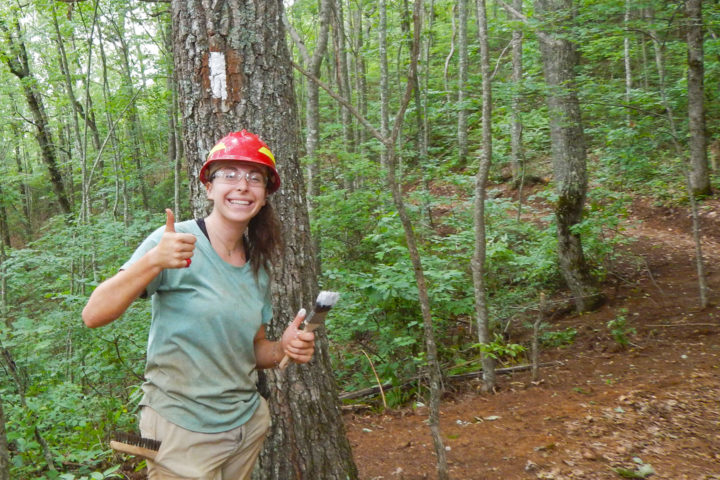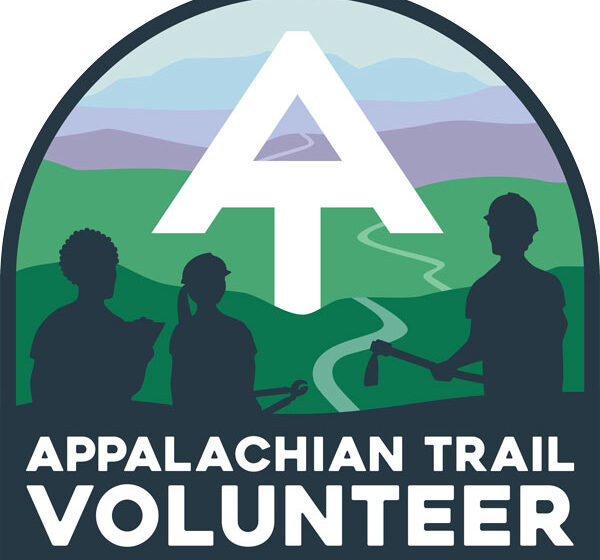New Look for Appalachian Trail Volunteers

The redesigned Volunteer logo captures the “onward and upward” spirit of A.T. volunteerism.
Can you see yourself as an Appalachian Trail (A.T.) volunteer? This was a guiding question when the ATC Volunteer Relations team began the careful process of updating the imagery associated with the A.T. Volunteer brand. As we enter the second century of caring for the People’s Trail, the ATC set out to make sure that it represents all people who contribute to this magnificent project. And while a fresh new logo is not the only way the organization is working to achieve this goal, helping prospective volunteers see themselves reflected in brand imagery is an important step.
Senior Director for Partnerships and Trail Operations, Leanna Joyner, shares some insights into the process of modernizing an iconic Volunteer brand to more accurately reflect the work of ATC volunteers and the volunteers themselves.
Q: Thanks for your time discussing the new brand, Leanna! Can you tell us what inspired the ATC Volunteer rebrand?

The previous Volunteer logo.
A: We had been using a colorized version of the Springer Mountain plaque with the addition of the word ‘volunteer’ on it for the last 20 years. When we embarked on this project, we had two guiding questions:
Does this image apply to the energy of what it means to be a volunteer?
Could we update the imagery so that all people and organizations that dedicate themselves to the A.T. could identify with it?
Q: Why does the volunteer program need a brand? Aren’t all volunteers associated with the ATC or Trail maintaining clubs – all of which have logos of their own?
A: “The whole is the sum of its parts,” the saying goes. Yes, each individual organization has its own identity, but the thread that unifies all of them is the shared care and effort contributed by volunteers. Every person and each organization is involved because they see this big project, spanning 14-states, known around the world, and want to contribute to keep it alive and make it better.
What’s unique about the Appalachian Trail is that it’s a project in something almost impossible: a protected trail weaving through 17 Forest Service Districts, 6 National Parks, 74 different state parks, forests, or game lands. More than just that, it’s cared for from a grassroots level by 30 A.T. Clubs. We wanted something that could be championed by all these public and private partners because it represents each of our efforts.
Q: Rebranding typically involves the work of a lot of stakeholders. Can you tell us about the consensus building process before, during, and after the rebrand launch?
A: We started with a survey of A.T. volunteers, staff at land management agencies, and personnel at ATC to dig to the ideas of volunteerism and the visual representation that best captures our shared work. Through that process, we learned a great deal. We held three focused community conversations with participation from A.T. Volunteers and staff at land management agencies. During these discussions, we verified our survey findings, then worked to cultivate ideas on style and important elements. As we drew close to our final decision-making for the design, we invited any past community participants back to gain perspectives again. It was very much a participatory process.
Along the way, we have kept A.T. Clubs and land managers updated at Regional Partnership Committee meetings, and we were delighted to offer them a sneak peek of the updated design in March this year before its debut!
Q: Logos are made up of lots of design choices and often include lots of symbolism that helps tell a brand’s story. Can you tell us about some of the important symbols/images in the new logo?
A: The first design choice we made is to have a contained mark that makes a perfect sticker and patch. We know people identify closely with how they spend their time and being able to have that represented on their water bottle, bumper, or sewn onto their backpack matters.
In terms of the visual components, the Appalachian Trail is central as it weaves through the ridges to the horizon. This “upward and onward” perspective is the kind of earnest, dedicated virtue our community is known for, and it also signals the next century of caring for the A.T. ahead of us.
We felt it was important to the design to include people, and so we have a silhouette of volunteers representing their unique roles and the community found in this shared purpose.
Q: The ATC is about to enter its second century and is an organization with a lot of history and tradition. Can you tell us about how you and your team thought about balancing that tradition with updating the volunteerism iconography during the rebranding process?
A: The Appalachian Trail Conservancy convenes and catalyzes partners for action in support of the Trail. Designed first as a confederation of A.T. Clubs, the Appalachian Trail Conservancy itself has evolved into an organization that brings the focus of the Appalachian Trail into broader context by more deeply working to protect and conserve lands and wildlife habitat.
Just as the ATC has evolved to bring greater resilience to the ecosystem services of the eastern seaboard, the ATC Volunteer team wanted to figure out how A.T. Volunteerism can be relevant and resilient into the future.
We know we stand on the shoulders of all the volunteers who have made the Trail what it is today. We carried an awareness for the connection current volunteers have for the program as we worked to reimagine the brand. Together we set out to craft a brand that marks an open invitation to new people, and respects the importance for new people to be able to see themselves as volunteers.
At the heart ATC’s work to convene partners, is the Cooperative Management System, a method of participatory civic engagement. In this way, volunteers don’t just sweat to care for the Trail, they also think to care for the Trail, playing an active role in management decisions. Our team applied the same approach to updating this imagery so that all partners can be collectively invested in this outcome to better represent all A.T. volunteers.
Q: When will people begin to see the new branding out on the Trail? What does the rollout process look like?
A: Volunteers will notice the change when they use the sign-up form for any events in the Volunteer Engagement Platform from now on. As we move into summer, volunteers participating in activities and accruing volunteer hours will receive volunteer recognition items with this new imagery.
Q: Is there anything else you’d like to share about the new brand or the design process?
A: I am so excited that we designed something that resonates with people. The feedback we have had so far has been amazing, and I’m really delighted to see where the next decade (or the next century) takes us!
Leanna Joyner is the Senior Director of Partnerships and Trail Operations with the ATC. She works to celebrate and sustain the Appalachian Trail’s volunteer management tradition that engages around 6,000 volunteers and 30 Trail maintaining clubs. Learn more about how to get started as an A.T. volunteer, or connect with your local Trail maintaining club.
Discover More

Learn More
About Volunteering
Learn more about volunteering on the Appalachian Trail and begin a volunteer journey that matches your skills, interest, and expectations.

From maintenance of the footpath and its facilities to greeting guests
Volunteer Opportunities
The Appalachian Trail (A.T.) would not exist without volunteers.

Read More
First-Time Volunteer Stories
Volunteers share their experiences maintaining the Appalachian Trail (A.T.) and its boundary for the first time.





